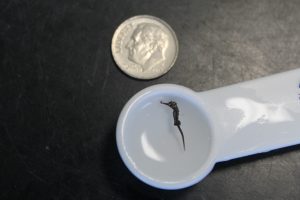
A baby seahorse is about 1/4 inch long when it is born and grows to the diameter of a dime in the first 7-10 days.
Aquarium Science students at Central Campus have been working to build one of the nation’s largest Ornamental Marine Aquaculture facilities in a high school for the past three years. It will be completed during the 2022-23 school year. Fortunately, good things are already starting to happen inside the 14,000 gallons of aquatic homes in the lab.
Thanks to generous donations from Aquarium Science alum Noah Belkhous (with Planted Materials) and Alyssa’s Seahorse Savvy, the Aquarium Science class was able to obtain six pairs of the Lined Seahorse (Hippocampus erectus) earlier this spring. The seahorses were doing so well under student care in the lab, they began breeding.
And now, the students in Aquarium Science would like to announce that their adult seahorse herd welcomed their first hatch of baby seahorses.
“I like raising seahorses because it’s something pretty cool and most people can’t say they have raised seahorses,” said senior Aurora Diemer (Roosevelt), who has studied at Central Campus for three years.
Seahorses are unique in that it is the male that becomes pregnant and gives live birth to the baby seahorses. The gestation period for a Lined Seahorse is approximately three weeks. The initial hatch was pretty small, but student’s expect larger hatches in the future as the seahorses become more mature. Once the seahorses get more practice, the number of fry per hatch should increase as will the frequency of births.
Students will continue to raise the seahorse fry in a dedicated aquarium system specially designed for the purpose. They will hatch live brine shrimp daily to feed them and to provide diligent care for the animals throughout each day, 7 days a week. A lot of work, but Diemer says that’s fine.
“If it was easy, everyone would be doing it,” she said.
Students expect many more birth announcements in the upcoming year with the addition of 60 new aquariums dedicated to pairing of ornamental marine fishes like clownfish, gobies, jawfish, dragonets, and pygmy angels. Diemer will take her experience here and build on it after graduation.
“I hope to turn my knowledge from Aquarium Science into a career working in a public aquarium someday,” she said.
If you are interested in helping save the oceans through aquaculture and exploring careers in public aquariums, pet trade, aquaculture or just want to learn the right way to set up your own fish tank at home, please contact your high school counselor today to find out how to register for the Aquarium Science class at Central Campus.





